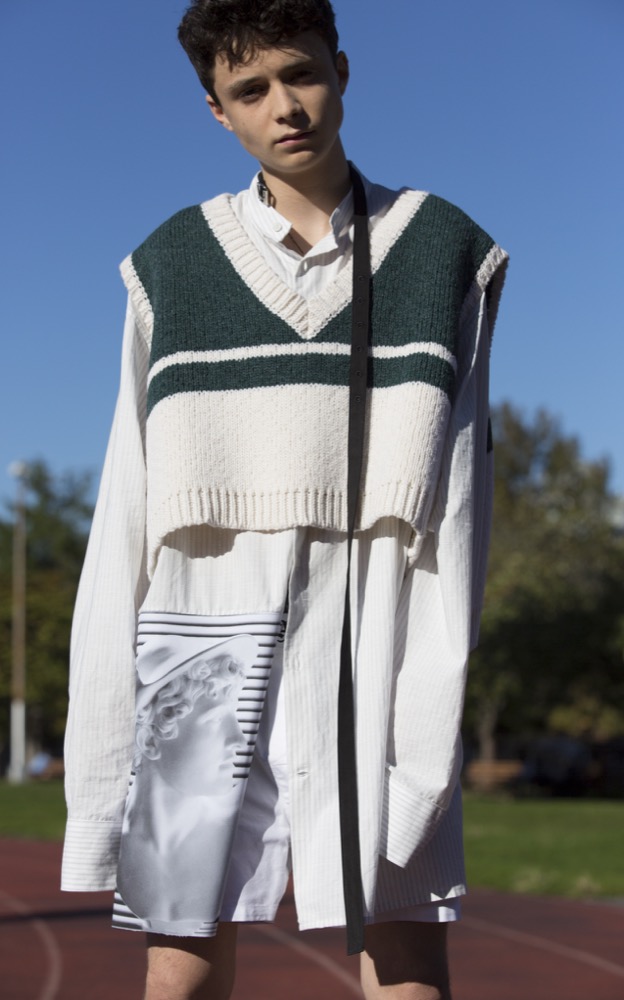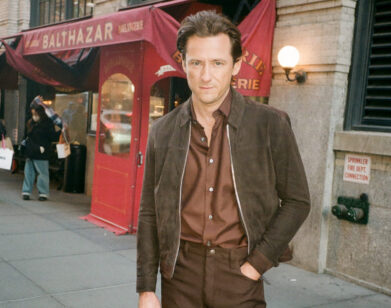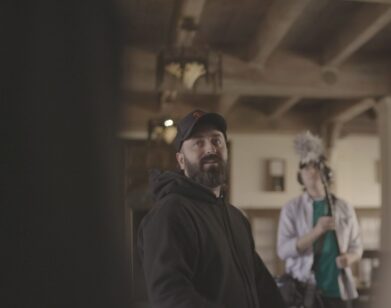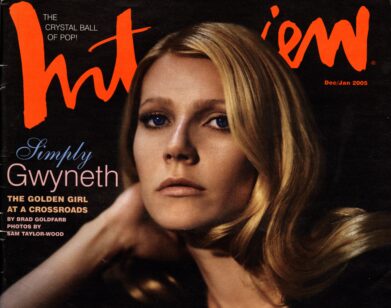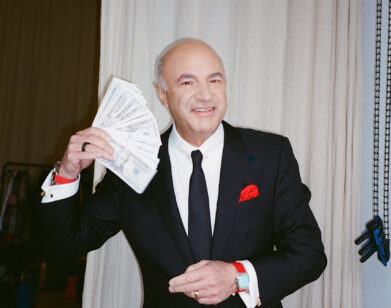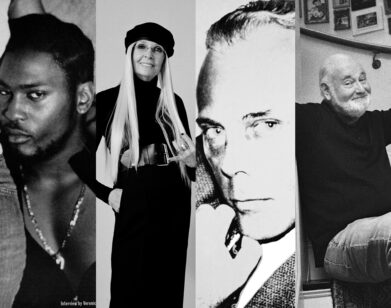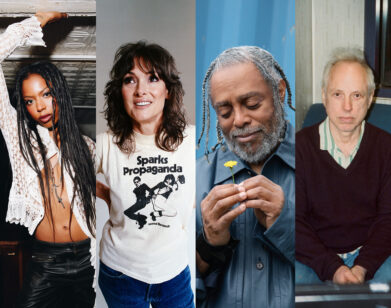The Precocious Rising Star
LUCAS JADE ZUMANN IN NEW YORK, OCTOBER 2016. PHOTOS: VICTORIA STEVENS. STYLING: SHIBON KENNEDY. GROOMING: NATE ROSENKRANZ FOR ALTERNA HAIR CARE/HONEY ARTISTS.
Lucas Jade Zumann would have you believe he’s “lucky.” When the 15-year-old Chicago native describes his rise to the silver screen, he says as much: “I was doing neighborhood plays, then I decided I wanted to audition for a professional play and I loved that process,” he explains. “I somehow got my foot in the door in the film career-audition world.” Based on Zumann’s performance in 20th Century Women, however, luck seems to be a minor factor.
Written and directed by Mike Mills and set in Santa Barbara in 1979, 20th Century Women features Zumann as budding punk teenager Jamie, the son of a single, bohemian mother named Dorothea (Annette Bening). Though Jamie is an only child, his house is filled with characters renting rooms from his mother, including the spiritual and warm handyman William (Billy Crudup), and the resilient Abbie (Greta Gerwig), whose recent bout with illness has left her in a shaky place. Along with Jamie’s older friend Julie (Elle Fanning)—who he’d rather have as a girlfriend—the collective serves as a kind of family, surveying the political, social, and cultural change of the time, as well as each other’s personal growth.
At the center of it all is Jamie and Dorothea’s relationship, which is at times both extremely evolved and extremely stunted. Zumann portrays Jamie as thoughtful yet deeply bewildered, grasping at the realities of the world as he loses the protection that youth provides. While relatable as a coming of age story, Jamie’s struggles to be a good son, a good person, and happy on his own terms have great nuance.
“Despite the fact that Jamie was a teenager, I still had to develop him without thinking, ‘He’s a teenager, so that means this,'” Zumann explains. “I had to first understand, ‘Yes, he’s a teenager,’ but then go into his own person. It turns out me and Jamie actually have a lot in common too.”
Speaking a few days after the world premiere of Women at the New York Film Festival in October, Zumann discussed the real reason he wants to act, bonding with his fictional mother, and how performance allows for self-acceptance.
AGE: 15.
HOMETOWN: I’m from Chicago. I’ve lived in the same neighborhood my whole life.
A PRECOCIOUS BEGINNING: From a very young age—I would say five years old—my mom set me up with this camp called Dharma camp. We learned meditation from this Buddhist monk. I did that until I was maybe 10 years old. Ever since then I’ve been practicing meditation religiously. I’ve found that I have a strong connection with the living things around me. I wanted to be able to use that to help other people.
A FAMILY OF ARTISTS: My whole family is musicians, actors. My mother did musical theater when she was a kid. My father plays a bunch of instruments. I think performance is in my blood for sure. They love that I decided to do acting. Of course, they didn’t force me into it—it was never something that I needed to do—they’ve always been supportive with any path that I might take. They are just as supportive that I decided to take the acting path.
ACTING AND ALTRUISM: It’s not that I don’t plan on pursuing acting forever, it’s just that my ultimate goal is to be a meditation guide and spiritual healer, along with studying plant medicine and stuff like that. I want to be able to do that without profit. I want to be able to provide medicine for people without them having to pay for it, since I think that’s something that reduces the value of the medicine. I think that having an acting career and a different source of income would allow me to help people without having to charge them.
EMPATHY AND PERFORMANCE: I think the empathy I have for all living things really helps [me] understand the way people think. I think that is what enables me to be able to play so many different characters; I can easily grasp the full understanding of a character.
GETTING CAST AS JAMIE: My agent set me up with this audition and it really stuck out to me. They sent me the script and just a few lines into it, I loved it. It was one of the most amazing things I had read for. I wanted it so bad. We were actually on vacation as a family in Orlando, and we had to film it on this little handheld, tourist recorder against this stucco, yellow hotel room wall. I was so upset. I was so distraught. It was such an amazing script and I knew that there was no way—with the circumstances and me having to memorize it in five hours—that I would be able to get the job.
I kind of gave up on it after a week of not hearing about it. Then, five weeks later or so, I got a call from my agent saying they wanted me to come in for a callback. This was L.A. casting, so I had to go to my agents and film it there in a more professional way so it wasn’t as bad. That got my courage up since I felt like I had a chance to be a part of this film. Then I didn’t hear anything for months.
A while later, I was taking this acting class with this casting director. At the end of the four days she was like, “You know my friend is casting this film that I think you would be amazing for. It’s about a mother and her only child.” I’m like, “What’s it called…?” She was like, “20th Century Women.” I said, “You know I read for that a few months back.” So she passed my name on to the casting director. It just so happened that at the same time that Mike Mills thought, “Okay, let’s take another look at Lucas,” and also passed down my name to the same casting director. The stars aligned in my direction. It was such a huge coincidence. [Mike] flew me out to California a few times and we met. Then he called me to say he wanted me to play Jamie.
SCHOOL AND FILMING: I had to take time off from high school. I did a home school-ish thing. After the film, I wanted to go back to traditional school right away. I had the school I wanted to go to send me the materials. I was working with my on-set teacher about three hours a day. I was packing a seven-hour day into about one to three hours, while still filming and memorizing lines. It was really tough, but I think it paid off since I was able to join the school and be with the class.
MOTHER AND SON, ON- AND OFF-SCREEN: [Annette and I] had a very interesting relationship. We kind of were like mother and son, actually. [laughs] We had a much better, healthier relationship as mother and son [off-camera] than we did on-camera—which helped us with the acting a ton. She was a huge mentor for me—an amazing role model. There was one specific thing she told me: I should spend as much, if not more, time off set as I do on set. I need grounding and a real life, as well as something to draw from. Acting is portraying life—you’re just bringing life into a different situation and you’re playing with it. If you have no experience in life then you can’t act. After the film, I did take a full year of a break. Those words really struck true to me.
UNSATISFYING FIRST VIEWING: I was ready to see it at the New York Film Festival, with the amazing soundtrack around my head and everything. Two days before the festival they said, “We want to make sure Lucas has seen the film before he goes.” They sent it to my laptop, and I had to watch it on my laptop [with] no headphones. It felt like someone was shoving a nice piece of cake down my throat. I wanted to sit down and tuck in my napkin and savor it, but they were like, “No, eat it as fast as you can so you can talk about it later.” I think actually seeing it with an audience was so amazing. I learned so much just being with an audience. Different people laugh at different times during the film. You can tell, “That person understood that because that’s the kind of person they are, and they’ve lived through that and understand that.”
DIFFERENT CHARACTERS, DIFFERENT PERSPECTIVES: There was one thing I noticed about Mike’s writing that came through when I was watching it, which is that you can watch this film five times, each time living vicariously through each character. It would be a totally different film each time. I experimented with that and it was almost as if the cinematography looked different. Mike did such a good job of developing each character, so each character is so true. That’s one of the things that I feel is going to be so amazing about this film—it’s going to be relatable for everybody and be a different film for everybody who’s watching it.
RELATING TO JAMIE: I think him being a teenager and going through that coming of age part of life—I too am going through that coming of age part of life. It was easy, but also hard to play Jamie because he is just a teenager—just like me. Some people would say, “He’s a teenager, so he’s this.” They’d make a whole list of things of what it means to be a teenager. But then what this film does is it actually puts into perspective that every person—despite where they were born, what era they were born in, what they look like, all that stereotypical stuff—is not defined by that stuff individually.
UNDERSTANDING PUNK: During that era was the punk scene. I didn’t understand the more destructive side of that. That was something I didn’t relate to very much. Mike actually sent me this big hard drive of books and things that I should research—short films to watch. Really studying all of that and coming to terms with the destructive side of punk and understand why people were this way, what motivated them to do the things they did, really helped in the back of my mind so I could be Jamie and carry through.
SELF-CRITIQUING: The first time I watched it, I [got self-conscious] because I was watching it through Jamie for some reason—I’m selfish, I don’t know. [laughs] I do get self-conscious watching my own work, so I [started] watching it through the eyes of Annette. Then the second time I watched it fully through Annette. I’m not super comfortable watching myself even if I don’t notice things about my acting that I don’t like. I know that subconsciously I’m taking notes on what I’m doing and even if it’s good I don’t want to change it later. I want to stay as a true, honest actor. I don’t want to act based on the things I didn’t like about my acting.
BRIDGING GENERATIONAL GAPS: [Jamie and Dorothea] are both looking to have a true relationship with each other but they don’t know how. They’re both going through struggles that either one of them can’t understand. Jamie doesn’t really understand what his mother is going through and she can’t really understand what Jamie’s going through. That in itself puts a barrier between them, as well as the barrier of their age difference and the times they were born in. Jamie was born in a completely different time than Dorothea was. She was raised in the Depression and he was raised in the era of punk. Those are two very different things—one cannot comprehend the other. They have a language barrier between them that keeps them from relating to one another honestly. I guess the whole movie is them trying to overcome that.
LEARNING FROM JAMIE: Doing any acting, you learn more about yourself because you’re taking the perspective of looking upon the character instead of being the character. Because I related a lot to Jamie, I was able to do a lot of self-reflection and maybe—not fix things, but come to accept things about myself that I didn’t really understand before.
FUTURE PLANS: I really like doing films. I don’t have any specific ones lined up, as ready as I am for the next project. I really like doing films like this one where everyone is doing it for the art. No one is doing it because it’s their job. They’re emotionally connected to it and they’re putting themselves into it. I think the other thing with this movie is you can see all the people who put their work into it. I am super happy that this first big film that I did had a cast and crew that was so emotionally invested in it. You can see their work on the screen. It’s super special to watch it. I understand how much work and emotion went into it.
20TH CENTURY WOMEN COMES OUT IN NEW YORK AND LOS ANGELES ON DECEMBER 25, 2016 WITH A WIDE RELEASE ON JANUARY 20, 2017.
For more from our “Faces of 2017” portfolio, click here.

